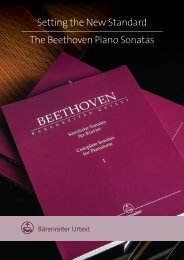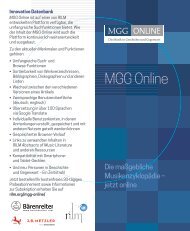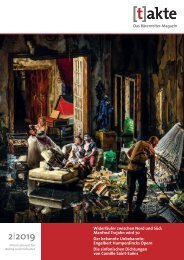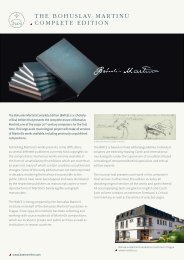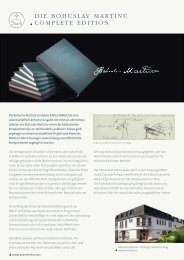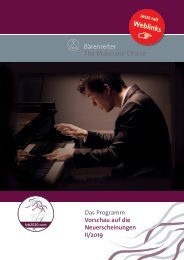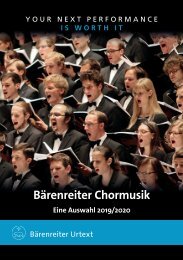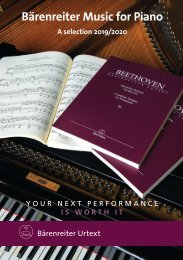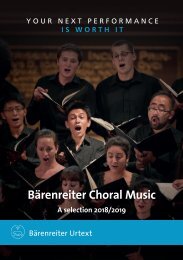You also want an ePaper? Increase the reach of your titles
YUMPU automatically turns print PDFs into web optimized ePapers that Google loves.
CARLO GESUALDO<br />
PRINCIPE DI VENOSA<br />
NEW GESUALDO EDITION<br />
OFFERTA DI SOTTOSCRIZIONE<br />
SUBSCRIPTION OFFER<br />
EINLADUNG ZUR SUBSKRIPTION<br />
Bärenreiter
L’EDIZIONE<br />
G. Balducci, Pala del Perdono (1609), Chiesa di Santa Maria<br />
delle Grazie (<strong>Gesualdo</strong>, AV)<br />
Cover: Particolare / Detail / Ausschnitt – Unico ritratto certo<br />
di / Only authentic portrait of / Einziges gesichertes Portrait<br />
von Carlo <strong>Gesualdo</strong><br />
La personalità di Carlo <strong>Gesualdo</strong> (Venosa 1566 – <strong>Gesualdo</strong> 1613),<br />
uno dei più grandi aristocratici italiani del suo tempo, principe<br />
di Venosa ma anche ‘principe dei musici’, considerato con Monte -<br />
verdi il maggiore compositore a cavallo tra Cinque e Sei cento,<br />
ha da sempre attratto l’attenzione di intellettuali e artisti, per la<br />
sua tormentata esistenza ma anche per la eccezionale qualità<br />
artistica della sua produzione. Già nell’anno della sua morte uno<br />
stimato maestro di cappella genovese, Simone Molinaro, realizzò<br />
una partitura dei cinque libri di madrigali a 5 e 6 voci, elevandoli<br />
a modello per lo studio del contrappunto e della composizione.<br />
Nel secolo scorso, l’entusiasmo di Igor Stravinskij per l’audace<br />
scrittura cromatica di <strong>Gesualdo</strong> diede vita a una vera e propria<br />
‘<strong>Gesualdo</strong> Renaissance’, e riportò con forza all’attenzione di<br />
studiosi e ascoltatori la densa polifonia vocale del Principe. Da<br />
allora molte iniziative di ricerca si sono succedute; ma le opere<br />
di Carlo <strong>Gesualdo</strong> da Venosa, rimaste fino a oggi affidate ad<br />
edizioni inadeguate sotto l’aspetto critico-testuale anche se<br />
storicamente importanti, necessitano ormai con urgenza di una<br />
vera edizione critica, condotta con metodi rigorosi e aggiornati,<br />
e funzionale sia alle moderne esigenze di studio sia a quelle della<br />
esecuzione storicamente informata.<br />
La musica di <strong>Gesualdo</strong> è stata tramandata da preziose stampe<br />
in libri-parte, prodotte da due famosi tipografi dell’epoca:<br />
Vittorio Baldini, stampatore privato del duca di Ferrara Ercole II<br />
THE EDITION<br />
Carlo <strong>Gesualdo</strong> (Venosa 1566 – <strong>Gesualdo</strong> 1613) was one of the<br />
most significant Italian aristocrats of his time; he was Prince of<br />
Venosa and simultaneously “Prince of musicians”. Together with<br />
Monteverdi he was considered the greatest composer at the turn<br />
of the 16 th to 17 th century, his personality attracting attention from<br />
intellectuals and artists both because of his tormented existence<br />
and the exceptional quality of his work. As early as the year of his<br />
death, an esteemed director of music from Genoa, Simone Molinaro,<br />
produced a score of his five books of 5 and 6-voice madrigals,<br />
designating them as models for the study of counterpoint and<br />
composition.<br />
In the last century, Igor Stravinsky’s enthusiasm for the daring<br />
chromatic writing of <strong>Gesualdo</strong> gave rise to a true “<strong>Gesualdo</strong><br />
Renaissance”, greatly attracting the attention of scholars and<br />
listeners to the complex vocal polyphony of the Prince. Since then,<br />
a long series of research projects have been undertaken.<br />
However, despite their historical significance, the editions of Carlo<br />
<strong>Gesualdo</strong> di Venosa’s works published so far, have turned out to be<br />
inadequate in terms of textual criticism. Hence the urgent need for<br />
a truly critical edition carried out on the basis of concise modern<br />
methods and suited to the needs of both scholarly research and<br />
historically informed performance practice.<br />
DIE EDITION<br />
Die Persönlichkeit Carlo <strong>Gesualdo</strong>s (Venosa 1566 – <strong>Gesualdo</strong> 1613),<br />
eines der bedeutendsten italienischen Aristokraten seiner Zeit, Fürst<br />
von Venosa und gleichzeitig „Fürst der Musiker“, zusammen mit<br />
Monteverdi als der größte Komponist an der Wende vom 16. zum<br />
17. Jahrhundert angesehen, hat von je her sowohl wegen seiner<br />
gequälten Existenz als auch der außergewöhnlichen künstlerischen<br />
Qualität seines Schaffens die Aufmerksamkeit von Intellektuellen<br />
und Künstlern auf sich gezogen. Bereits in dessen Todesjahr erstellte<br />
der geachtete genuesische Kapellmeister Simone Molinaro eine<br />
Partitur der fünf Madrigalbücher zu 5 und 6 Stimmen und erhob<br />
sie zu Modellen für das Studium des Kontrapunkts und der Kom -<br />
position. Im letzten Jahrhundert löste Igor Strawinskys Enthusiasmus<br />
für den gewagten chromatischen Satz des Kom ponisten eine<br />
wahre „<strong>Gesualdo</strong>-Renaissance“ aus, die mit Nach druck die Aufmerksamkeit<br />
von Forschern und Hörern auf die dichte Poly phonie<br />
des Fürsten lenkte. Seitdem gab es viele Forschungs-Ini tia tiven;<br />
jedoch blieben die bislang vorgelegten Editionen der Werke<br />
von Carlo <strong>Gesualdo</strong> da Venosa, trotz ihrer historischen Bedeutung,<br />
unter textkritischem Aspekt bis heute unzu länglich. Hieraus<br />
ent stand notwendiger weise das Bedürfnis nach einer wirklich<br />
kri ti schen Edition, die auf strengen und zeit gemäßen Methoden<br />
fußt, und dabei den heutigen Ansprüchen sowohl der Forschung<br />
als auch der historisch informierten Aufführungspraxis dient.<br />
<strong>Gesualdo</strong>s Musik ist in kostbaren Stimmbüchern überliefert, die<br />
von zwei berühmten Druckern des 16. Jahrhunderts produziert
Castello di Venosa<br />
d’Este, e Giovanni Giacomo Carlino, rinomato tipografo<br />
napoletano che il Principe fece trasferire nel suo castello di<br />
<strong>Gesualdo</strong> per stampare i suoi tre ultimi libri.<br />
Purtroppo non tutte le prime edizioni ci sono pervenute<br />
com plete, pertanto è necessario ricorrere alle riedizioni<br />
immedia tamente successive per ricostruire integralmente<br />
i testi musicali. Queste ristampe sono comunque molto<br />
importanti anche perché testimoniano la diffusione che la<br />
musica di <strong>Gesualdo</strong>, e in particolare i suoi madrigali, ebbe<br />
fin da subito. Oltre ai sei libri di madrigali a cinque voci<br />
giunti fino a noi (un libro postumo a 6 voci è purtroppo<br />
incompleto) sopravvivono di Carlo <strong>Gesualdo</strong> tre libri di<br />
musica sacra, composti nel Castello di <strong>Gesualdo</strong>, che rivelano<br />
un livello artistico altrettanto elevato anche se meno<br />
apertamente sperimentale, e alcune composizioni vocali e<br />
strumentali sparse in antologie o manoscritti.<br />
Arms of <strong>Gesualdo</strong> (black lion with<br />
five lilies), from the tomb plate of<br />
Carlo <strong>Gesualdo</strong> (Naples, Church<br />
of Gesù Nuovo)<br />
La nuova Edizione critica parte dall’esame di tutti i testimoni<br />
esistenti, sia a stampa che manoscritti, criticamente<br />
esaminati nel loro contesto, procedendo per la prima volta<br />
ad una reale valutazione della loro origine ed autorevolezza.<br />
Testimoni privilegiati sono le prime edizioni, che sono<br />
uscite tutte sotto il controllo diretto di <strong>Gesualdo</strong>. Viene<br />
presa in considerazione anche la Partitura realizzata da<br />
Molinaro per la sua indiscutibile importanza storica, in<br />
quanto testimone d’eccellenza per la ricezione di <strong>Gesualdo</strong><br />
in epoca moderna.<br />
The music of <strong>Gesualdo</strong> is handed down in precious part-book prints<br />
produced by two famous 16 th -century printers: Vittorio Baldini,<br />
private printer of Ercole II d’Este, Duke of Ferrara, as well as<br />
Giovanni Giacomo Carlino, a well-known Neapolitan printer, whom<br />
<strong>Gesualdo</strong> asked to move to his village to print his last three partbooks.<br />
Unfortunately, not all the first editions have survived in their<br />
entirety, hence the need to examine the surviving editions which<br />
immediately followed in order to reconstruct the complete musical<br />
texts. These reprints are also significant because they document<br />
the wide circulation that the music of <strong>Gesualdo</strong>, in particular his<br />
madrigals, enjoyed from the beginning. Aside from the six books<br />
of five-part madrigals (a posthumous six-part book is unfortunately<br />
incomplete), three books by <strong>Gesualdo</strong> with sacred music of the same<br />
artistic level but not so experimental, composed at the Castle of<br />
<strong>Gesualdo</strong>, as well as some of his vocal and instrumental compositions<br />
found in anthologies or manuscripts have survived.<br />
The new critical edition starts with a review of all existing printed<br />
and manuscript sources, and proceeds to evaluate their degree of<br />
authoritativeness for the very first time. The very first editions<br />
are the preferred sources, since they were all issued under the direct<br />
supervision of <strong>Gesualdo</strong>. Molinaro’s Partitura is also taken into<br />
account for its unquestionable historical significance and as evidence<br />
of <strong>Gesualdo</strong>’s reception in modern times.<br />
worden sind: Vittorio Baldini, Privatdrucker des Herzogs von Ferrara,<br />
Ercole II d’Este, sowie Giovanni Giacomo Carlino, ein renommierter<br />
neapolitanischer Drucker, den <strong>Gesualdo</strong> eigens an seinen Wohnsitz<br />
kommen ließ, um seine drei letzten Bücher zu drucken.<br />
Leider sind die Erstauflagen nicht alle vollständig überliefert, so<br />
dass es nötig ist, zur Erschließung der musikalischen Texte auch<br />
die unmittelbar nachfolgenden Editionen heranzuziehen. Diese<br />
Nachdrucke sind auch deshalb von großer Bedeutung, weil sie<br />
die Verbreitung bezeugen, die <strong>Gesualdo</strong>s Musik, insbesondere seine<br />
Madrigale, von Anfang an erfuhr. Neben den sechs Büchern mit<br />
Madrigalen zu fünf Stimmen (ein nachgelassenes sechsstimmiges<br />
Buch ist leider unvollständig) sind von Carlo <strong>Gesualdo</strong> drei im<br />
Schloss von <strong>Gesualdo</strong> komponierte Bücher mit geistlicher Musik<br />
überliefert, die sich auf demselben artistischen Niveau bewegen,<br />
ihren experimentellen Anteil aber weniger offen zeigen, ferner einige<br />
vokale und instrumentale Kompositionen, die sich in Anthologien<br />
oder Manuskripten finden.<br />
Die neue kritische Edition geht von der Sichtung aller existierenden<br />
Quellen aus, seien dies Drucke oder Manuskripte, und bewertet<br />
sie erstmals wirklich hinsichtlich ihres Ursprungs und ihrer Maß -<br />
geblichkeit. Bevorzugte Quellen sind die Ersteditionen, die sämtlich<br />
unter der direkten Überwachung <strong>Gesualdo</strong>s herauskamen.<br />
Auch die von Molinaro geschaffene Partitura wird wegen ihrer unbestreitbaren<br />
historischen Bedeutung und als mustergültiges Zeugnis<br />
für die Rezeption <strong>Gesualdo</strong>s in neuerer Zeit berücksichtigt.
NORME EDITORIALI<br />
La ‘New <strong>Gesualdo</strong> Edition’ si pone un duplice obiettivo:<br />
offrire un’agevole e moderna edizione per gli interpreti<br />
e fornire un approfondito strumento di ricerca per gli studiosi.<br />
Per ottenere ciò l’edizione:<br />
• si basa ove esistenti sulle edizioni a stampa controllate<br />
dall’autore;<br />
• fornisce una trascrizione in partitura, formalizzata secondo<br />
il tactus;<br />
• propone una duplice veste per i testi poetici, funzionale allo<br />
studio letterario e alla corretta intonazione in sede esecutiva;<br />
• visualizza negli apparati i diversi livelli testuali, che<br />
testimoniano i processi di tradizione e ricezione dei<br />
testi poetici e musicali.<br />
Particolare attenzione è riservata alle alterazioni, per le quali<br />
viene ripristinato l’originale ‘sistema gesualdiano’. Per i sei libri<br />
di Madrigali, data l’importanza rivestita dalla Partitura curata<br />
da Molinaro, e dal suo particolarissimo criterio di barratura in<br />
‘caselle’, nella nuova edizione viene visualizzata sopra il primo<br />
pentagramma la scansione, così come si presenta nella Partitura<br />
del 1613.<br />
Carlo <strong>Gesualdo</strong>, ‘Madrigali a cinque voci. Libro quinto’, ALTO.<br />
<strong>Gesualdo</strong>, G. G. Carlino 1611, Frontespizio / Title page / Titel blatt<br />
(Napoli, Biblioteca del Conservatorio ‘San Pietro a Majella’).<br />
EDITORIAL PRINCIPLES<br />
The “New <strong>Gesualdo</strong> Edition” sets itself a twofold aim:<br />
to provide both a practical modern edition for performers<br />
as well as an in-depth research tool for scholars.<br />
In order to achieve this, the edition:<br />
• is based on the prints supervised by the composer, if available;<br />
• provides a score transcription structured according to the<br />
tactus principle;<br />
• presents poetic texts which enable their study with regard<br />
to literary aspects and musical application;<br />
• breaks down the various levels of the genesis and reception<br />
processes regarding the poetic and musical texts in the apparatus.<br />
Special attention is paid to alterations, for which the original<br />
“Gesualdian system” has been restored. Given the importance of<br />
Molinaro’s Partitura and its distinctive division into “caselle”, the<br />
new edition, in the six madrigal volumes, presents these divisions<br />
by means of a dotted line above each first pentagram exactly as it<br />
appears in the 1613 Partitura.<br />
EDITIONSPRINZIPIEN<br />
Die „New <strong>Gesualdo</strong> Edition“ setzt sich ein zweifaches Ziel: Zum<br />
einen den Interpreten eine praktikable moderne Edition zu bieten,<br />
zum anderen der Wissenschaft eine vertiefte Forschungsgrundlage<br />
zur Verfügung zu stellen.<br />
Dies bedeutet, dass die Edition:<br />
• auf den vom Komponisten kontrollierten Druckausgaben<br />
basiert, soweit vorhanden;<br />
• eine dem tactus-Prinzip folgende Partitur-Transkription gibt;<br />
• die poetischen Texte in zweifacher Gestalt bietet, um ihr<br />
Studium unter literarischem Aspekt genauso zu ermöglichen<br />
wie ihre korrekte Umsetzung bei Aufführungen;<br />
• im Apparat die verschiedenen Ebenen aufschlüsselt, die den<br />
Überlieferungs- und Rezeptionsprozess von poetischem und<br />
musikalischem Text belegen.<br />
Besondere Aufmerksamkeit ist den Alterationen gewidmet. Für<br />
sie wurde das originale „Gesualdanische System“ wieder in Kraft<br />
gesetzt. In den sechs Madrigal-Bänden werden in der neuen<br />
Edition in Anbetracht der Bedeutung von Molinaros Partitura<br />
und ihrer Besonderheit der Untergliederung in „caselle“ diese<br />
Gliederungseinheiten in genauer Entsprechung zur Partitura<br />
von 1613 durch gestrichelte Linien über dem jeweils obersten<br />
Pentagramm kenntlich gemacht.
Es. di Madrigale di <strong>Gesualdo</strong> con divisione in ‘caselle’, dalla ‘Partitura’ pubblicata da Molinaro nel 1613. /<br />
Ex. of <strong>Gesualdo</strong>’s madrigals with its division into “caselle” from the “Partitura” published by Molinaro in 1613. /<br />
Bsp. eines Madrigals <strong>Gesualdo</strong>s mit Untergliederung in „caselle“ aus der 1613 von Molinaro herausgegebenen „Partitura“<br />
(Napoli, Biblioteca del Conservatorio ‘San Pietro a Majella’).<br />
New <strong>Gesualdo</strong> Edition, BA 10385-01, p. / S. 44<br />
Alterazioni / Alterations / Alterationen<br />
“Caselle”
Carlo <strong>Gesualdo</strong>, ‘Madrigali<br />
a cinque voci. Libro quinto’,<br />
QUINTO. <strong>Gesualdo</strong>, G. G.<br />
Carlino 1611, p. / S. 21 (Napoli,<br />
Biblioteca del Conservatorio<br />
‘San Pietro a Majella’).<br />
LA SOTTOSCRIZIONE<br />
L’edizione consta di dodici volumi.<br />
I volumi possono essere acquistati singolarmente, oppure<br />
è possibile prenotare l’opera completa a un prezzo ridotto.<br />
Ciascun volume contiene una Introduzione (in italiano e in<br />
inglese), una sezione di documenti e l’edizione dei testi intonati,<br />
accompagnati da un commento critico (in italiano e in inglese).<br />
Formato 23 x 30 cm, tela<br />
THE SUBSCRIPTION<br />
The edition will comprise twelve volumes.<br />
They can be purchased individually or the whole series<br />
can be subscribed to at reduced prices.<br />
Each volume contains a Preface (Ital / Eng), a facsimile section,<br />
a critical edition of the texts set to music as well as a Critical<br />
Commentary (Ital / Eng).<br />
Format 23 x 30 cm, linen-bound<br />
DIE SUBSKRIPTION<br />
Die Ausgabe umfasst zwölf Bände. Sie können einzeln bezogen<br />
oder komplett zu reduzierten Preisen subskribiert werden.<br />
Jeder Band enthält ein Vorwort (ital. / engl.), einen Abbildungsteil,<br />
eine Edition der vertonten Texte, ferner einen Kritischen Bericht<br />
(ital. / engl.).<br />
Format 23 x 30 cm, Leinen
New <strong>Gesualdo</strong> Edition,<br />
BA 10385-01, p. / S. 84<br />
PIANO EDITORIALE / PUBLICATION SCHEDULE / EDITIONSPLAN<br />
Iniziando col volume Madrigali a cinque voci.<br />
Libro quinto, pubblicato nel 2018, intendiamo<br />
pubblicare due volumi all’anno.<br />
Beginning with the volume Madrigali a cinque voci.<br />
Libro quinto which will be published in 2018,<br />
approximately two volumes will appear per year.<br />
Beginnend mit dem Band Madrigali a cinque voci.<br />
Libro quinto, der 2018 erscheint, werden in der Regel<br />
zwei Bände pro Jahr vorgelegt.<br />
Sacrarum cantionum liber primus (a sei e sette voci)<br />
(Napoli 1603). A cura di / Ed. by / Hrsg. von Marc Busnel,<br />
Cristina Cassia BA 10388-01<br />
Responsoria et alia ad Officium Hebdomadae Sanctae spectantia<br />
(<strong>Gesualdo</strong> 1611). A cura di / Ed. by / Hrsg. von Rodobaldo Tibaldi<br />
2018 BA 10389-01<br />
Miscellanea di brani apparsi in antologie e manoscritti. Musica<br />
strumentale. Madrigali a sei voci (Napoli 1626). A cura di /<br />
Ed. by / Hrsg. von Dinko Fabris, John Griffiths BA 10390-01<br />
Bibliografia testuale<br />
A cura di / Ed. by / Hrsg. von Francesco Saggio BA 10391-01<br />
Madrigali a cinque voci. Libro primo (Ferrara 1594)<br />
A cura di / Ed. by / Hrsg. von Marco Dalla Sciucca BA 10381-01<br />
Madrigali a cinque voci. Libro secondo (Ferrara 1594)<br />
A cura di / Ed. by / Hrsg. von Marco Mangani BA 10382-01<br />
Madrigali a cinque voci. Libro terzo (Ferrara 1595)<br />
A cura di / Ed. by / Hrsg. von Francesco Saggio BA 10383-01<br />
Madrigali a cinque voci. Libro quarto (Ferrara 1596)<br />
A cura di / Ed. by / Hrsg. von Daniele Sabaino BA 10384-01<br />
Madrigali a cinque voci. Libro quinto (<strong>Gesualdo</strong> 1611)<br />
A cura di / Ed. by / Hrsg. von Maria Caraci Vela € 249.00<br />
3 / 2018 BA 10385-01<br />
Madrigali a cinque voci. Libro sesto (<strong>Gesualdo</strong> 1611)<br />
A cura di / Ed. by / Hrsg. von Antonio Delfino BA 10386-01<br />
Regesto dei Documenti e Bibliografia generale<br />
A cura di / Ed. by / Hrsg. von Agostino Ziino BA 10392-01<br />
Comitato Scientifico consultivo<br />
Scholarly Advisory Commitee<br />
Wissenschaftlicher Beirat<br />
Claudio Abbado †<br />
Presidente onorario / Honorary Chairman / Ehrenvorsitzender<br />
Glenn Watkins Presidente / Chairman / Vorsitzender<br />
Maria Caraci Vela · Dinko Fabris · Iain Fenlon ·<br />
Anthony Newcomb · Philippe Vendrix · Agostino Ziino<br />
Comitato Editoriale<br />
Executive Editors<br />
Herausgebergremium<br />
Maria Caraci Vela · Dinko Fabris · Agostino Ziino<br />
Sacrarum cantionum liber primus (a cinque voci)<br />
(Napoli 1603). A cura di / Ed. by / Hrsg. von Paolo Da Col,<br />
Rodobaldo Tibaldi BA 10387-01
COMITATO EDITORIALE || EDITORIAL COMMITTEE || HERAUSGEBERGREMIUM<br />
Maria Caraci Vela è stata professore ordinario di<br />
Filologia musicale, Storia della musica rinascimen<br />
tale e Storia e critica dei testi musicali medievali<br />
e rinascimentali, membro di vari comitati<br />
scientifici e coordinatrice di diverse ricerche inter <br />
nazionali. Recentemente ha pubblicato La filologia<br />
musicale: Istituzioni, storia, strumenti critici<br />
(3 voll., Lucca, LIM, 2005 – 2013; Musical Philology.<br />
Institutions, History, and Critical Approaches, vol. I,<br />
Historical and Methodological Fundaments of<br />
Musical Philology, Pisa, ETS, 2015).<br />
Maria Caraci Vela was Full Professor of Music<br />
Philology, History of Renaissance Music as well<br />
as History and Criticism of Musical Texts of the<br />
Middle-Ages and Renaissance, member of various<br />
scholarly committees and coordinator of various<br />
international research projects. She is author of<br />
La filologia musicale: Istituzioni, storia, strumenti<br />
critici (3 vols., Lucca, LIM, 2005–2013; Musical<br />
Philology. Institutions, History, and Critical<br />
Approaches, vol. I, Historical and Methodological<br />
Fundaments of Musical Philology, Pisa, ETS, 2015).<br />
Maria Caraci Vela war Ordinaria für Musikphilologie,<br />
Geschichte der Musik der Renaissance<br />
sowie Geschichte und Kritik von Texten zur Musik<br />
des Mittelalters und der Renaissance, zudem<br />
Mitglied mehrerer wissenschaftlicher Gremien<br />
und Koordinatorin verschiedener internationaler<br />
Forschungsprojekte. Sie ist die Autorin von<br />
La filologia musicale: Istituzioni, storia, strumenti<br />
critici (3 Bde., Lucca, LIM, 2005–2013; Musical<br />
Philology. Institutions, History, and Critical<br />
Approaches, vol. I, Historical and Methodological<br />
Fundaments of Musical Philology, Pisa, ETS, 2015).<br />
Dinko Fabris è docente di Storia della Musica nel<br />
Conservatorio di Napoli e nell’Università della<br />
Basilicata. Inoltre è professore esterno all’Università<br />
di Leiden e membro di diversi comitati<br />
internazionali, tra cui Commission Mixte del RISM<br />
e Pontificio Consiglio della Cultura. Primo presidente<br />
italiano della International Musicological<br />
Society (2012–2017), ha dedicato numerose<br />
pubblicazioni principalmente a Napoli e alla musica<br />
europea fra 1500 e 1800, tra cui Music in Seventeenth-century<br />
Naples (Ashgate 2007,<br />
repr. Routledge 2016).<br />
Dinko Fabris is lecturer of History of Music at the<br />
Conservatorio di Napoli and at the University of<br />
Basilicata, guest lecturer at the University of<br />
Leiden as well as member of several international<br />
committees, amongst them the Commission<br />
Mixte of RISM and the Pontificio Consiglio della<br />
Cultura. From 2012 to 2017 he was President of<br />
the International Musicological Society. He has<br />
published widely on the music history of Naples<br />
and European music between 1500 – 1800, e.g.<br />
Music in Seventeenth-century Naples (Ashgate<br />
2007, reprint Routledge 2016).<br />
Dinko Fabris ist Dozent für Musikgeschichte am<br />
Konservatorium von Neapel und an der Uni ver <br />
sität der Basilicata, ferner Gastprofessor an<br />
der Universität Leiden und Mitglied verschiedener<br />
internationaler Gremien wie der Commission<br />
Mixte von RISM und des Pontificio Consiglio della<br />
Cultura. Von 2012 bis 2017 war er Präsident der<br />
International Musicological Society. Zahlreiche<br />
Publikationen vor allem zur Musikgeschichte<br />
Neapels und zur europäischen Musik zwischen<br />
1500 und 1800, darunter Music in Seventeenthcentury<br />
Naples (Ashgate 2007, Neuauflage<br />
Routledge 2016).<br />
Agostino Ziino, professore emerito di musicologia<br />
dell’Università di Roma Tor Vergata e presidente<br />
dell’Istituto Italiano per la Storia della Musica, è<br />
studioso specialista di musica italiana dei secoli<br />
XIII-XVI. Oltre a svariati saggi sulla musica e i<br />
musicisti italiani dal Medioevo al Rinascimento,<br />
è autore dell’edizione in facsimile del Codice di<br />
Torino, Biblioteca Nazionale Universitaria, T.III.2<br />
(Lucca 1994) e, con John Nádas, di quella del<br />
Codice di Lucca (Lucca 1990).<br />
Agostino Ziino, Professor emeritus of Musicology<br />
at the University of Rome Tor Vergata, now<br />
Presi dent of the Istituto Italiano per la Storia della<br />
Musica, specializes in Italian music of the 13 th to<br />
16 th centuries. In addition to various articles on<br />
the music and musicians from the Middle Ages<br />
to Renaissance Italy, he is the author of the<br />
facsimile edition of the Codex Torino, Biblio teca<br />
Nazionale Universitaria, T.III.2 (Lucca 1994) and,<br />
with John Nádas, of the Lucca Codex (Lucca 1990).<br />
Agostino Ziino, Professor emeritus für Musikwissenschaft<br />
an der Universität Rom Tor Vergata,<br />
ist seit 2007 Präsident des Istituto Italiano per<br />
la Storia della Musica in Rom. Sein Forschungsschwerpunkt<br />
liegt auf der italie ni schen Musik<br />
des 13. bis 16. Jahrhunderts. Neben unterschiedlichen<br />
Beiträgen zu Musik und Musi kern dieses<br />
Zeitraums gab er die Faksimile Edition des Codex<br />
Torino, Biblioteca Nazionale Universitaria, T.III.2<br />
(Lucca 1994) sowie des Lucca Codex (Lucca 1990,<br />
zusammen mit John Nádas) heraus.<br />
La ‘New <strong>Gesualdo</strong> Edition’ è resa possibile dal generoso contributo<br />
delle seguenti istituzioni: / The “New <strong>Gesualdo</strong> Edition” is made<br />
possible by the generous support of the following institutions: /<br />
Die Ausgabe „New <strong>Gesualdo</strong> Edition” wird durch die groß zügige<br />
Unterstützung folgender Institutionen ermöglicht:<br />
Comitato per le Celebrazioni Gesualdine – Regione Basilicata<br />
Fondazione Carlo <strong>Gesualdo</strong> – Regione Campania<br />
Il vostro negozio specializzato /<br />
Your music dealer / Ihr Fachhändler<br />
Bärenreiter<br />
Bärenreiter-Verlag Karl Vötterle GmbH & Co. KG<br />
Heinrich-Schütz-Allee 35 – 37 · 34131 Kassel<br />
Germania · Germany<br />
info@baerenreiter.com · www.baerenreiter.com<br />
Salvo errori. Modalità di consegna riservate<br />
Errors excepted; delivery terms subject to change without notice<br />
Irrtum und Lieferungsmöglichkeiten bleiben vorbehalten<br />
Printed in Germany · 1 / 2018 · SPA 274









